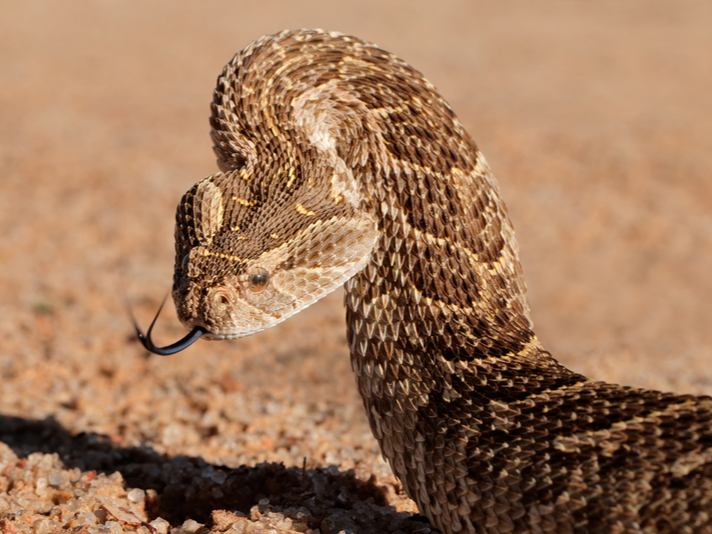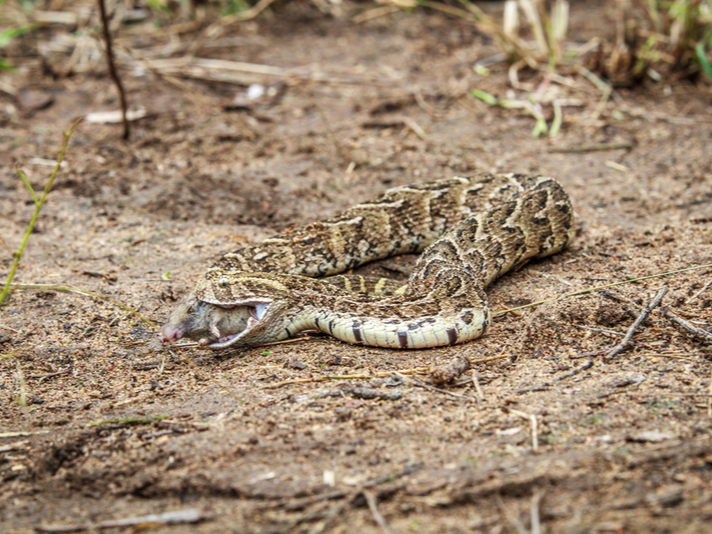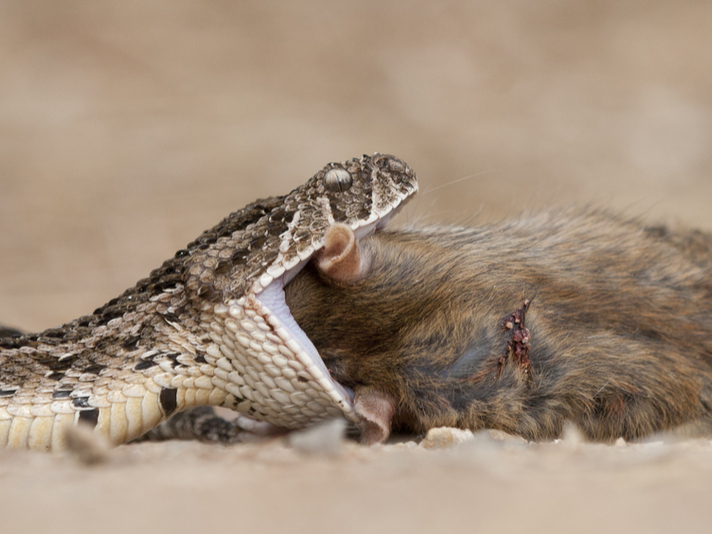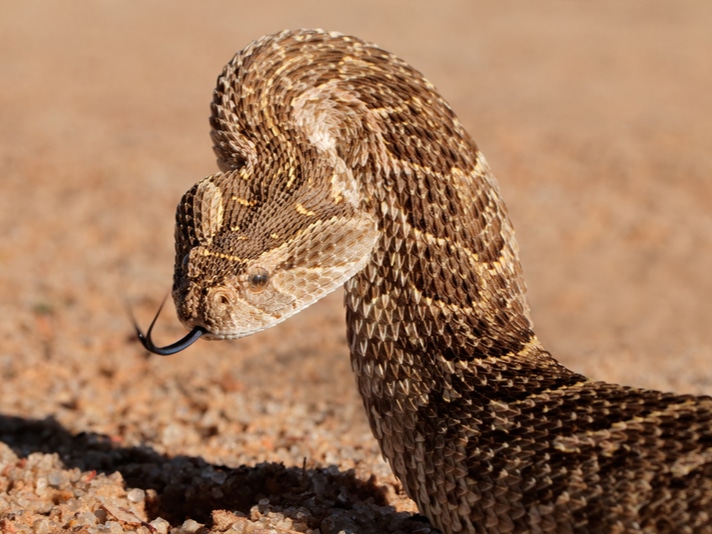Study reveals unexpected behavior in wild puff adders.
The puff adder (Bitis arietans) is a heavy-bodied, medium-sized snake belonging to the family Viperidae. It occurs in savannahs and open woodlands throughout most of sub-Saharan Africa and parts of the Arabian Peninsula.

EcoPrint/Shutterstock
Mammals and amphibians made up the bulk of a puff adder's diet, but the snakes also took birds and lizards when given the opportunity.
Despite being one of Africa’s most iconic, widespread, common and medically important (for the production of antivenin) snakes, little is known about the puff adder’s ecology. To help fill this gap in knowledge, we conducted a three-and-a-half-year field study on B. arietans in the Dinokeng Game Reserve, Gauteng Province, South Africa, during which we implanted radio transmitters into puff adders so we could easily track the snakes with the specific objective of learning about their natural foraging behavior. We used radio telemetry in conjunction with fixed videography, a technique that involved the set up of continuously recording video cameras with the goal being to record interactions between wild puff adders and their prey. Puff adders are ideal subjects for such studies because they lie in wait for extended periods, sometimes days or weeks, to ambush prey.
Our research resulted in one of the most in-depth studies ever conducted on the foraging ecology of a snake species in nature. It was greatly facilitated by Gerd and Tienie Graf, the owners of iKhaya lamaDube Game Lodge (ikhayalamadube.co.za/), who provided us with free accommodations during the entire study, and by the Committee for Research and Exploration at the National Geographic Society, which partially funded our research.
Opportunistic Predator
We implanted transmitters in 86 puff adders and recorded nearly 5,000 hours of puff adder foraging behavior in the wild. We first used this information to characterize the diet of puff adders, and what we discovered was that although mammals have been reported in the scientific literature to be the puff adder’s primary prey, our videography data revealed that this is not the case because mammals and amphibians were consumed in equal numbers. These findings also differ from dietary estimates that we collected through the dissection of preserved museum specimens, a traditional data-collecting method often used by scientists to study snake diet.
We believe that the higher proportion of mammals in museum specimens is due to the fact that amphibians are more rapidly and efficiently digested in comparison to mammal prey. Examination of the digestive tracts of museum specimens often yields only indigestible prey remains, such as hair, feathers or scales, which are also typically the only identifiable prey parts found in snake feces. Because amphibians lack these indigestible structures, their importance in snake diet can be easily overlooked, causing results of the dissection technique to be biased.
In any case, the videography data demonstrated that the puff adders in our study were opportunistic ambush hunters that fed on all classes of terrestrial vertebrates. Mammals and amphibians made up the bulk of their diet, but the snakes also took birds and lizards when given the opportunity. The relatively rare occurrence of birds and lizards in the puff adder diet is possibly due to the snakes having fewer opportunities to catch these types of prey because birds and lizards are mostly active during the day, in contrast to small mammals and amphibians that are often nocturnal, and puff adders typically forage at night (18 of 24 instances of puff adders ambushing prey while being recorded by our video cameras occurred at night).
Puff Adders Eat Small Prey
An interesting and unexpected discovery revealed by the video cameras was that puff adders feed mostly on relatively small prey. Ambush-foraging snakes such as B. arietans are generally thought to mainly eat very large meals, but our measures indicated that most of the snakes’ meals weighed less than 5 percent of a snake’s body mass (18 of 23 prey items). A few of their meals were even minuscule, weighing less than 1 percent (comprised of two frogs and a shrew). Although puff adders certainly can consume very large meals (we recorded one meal, a Rhabdomys mouse species, which was 127 percent of the snake’s mass!), most meals are relatively small. Therefore, our videography data indicates that the belief that ambush-foraging snakes feed infrequently on prey of relatively large size does not apply to puff adders.

Simon Eeman/Shutterstock
Puff adder feeding on a mouse in the Kruger National Park, South Africa.
Further, puff adders in our study fed once every 10 days on average, which is a lot more often than expected for an ambush-foraging snake. Again, this thinking may be due more to the conventional methods used to collect the information. Studies relying on dissections of museum specimens or regurgitation by palpation on free-ranging snakes — another commonly used data-collection technique — may decrease our perception of feeding frequency because small and inefficiently digested meals are easily overlooked. Fixed videography data on puff adders and some other ambush-foraging snakes, such as timber rattlesnakes (Crotalus horridus) and northern Pacific rattlesnakes (C. oreganus), support this idea because the video cameras demonstrated that they feed more often than was conventionally assumed (every six to 10 days rather than every three to four weeks).
Puff Adder Luring Behavior
In addition to clarifying the diet and feeding ecology of wild puff adders, our data revealed complex and, we believe, previously unknown behaviors and strategies used by puff adders. Predators are known to use a variety of tactics to increase their chances of capturing prey, including behaviors to lure prey to within striking range. Our video data showed that puff adders will extend their tongues in a way that mimics a worm (lingual luring) and also waved their tails (caudal luring) to mimic an invertebrate, both in order to attract prey to within striking range and so increase their foraging success.
Lingual luring occurred only in response to the presence of a frog, indicating that this behavior is a frog-specific hunting technique, and that puff adders can discriminate amphibians from small mammals, lizards and birds, even in the dark of night when most puff adder hunting takes place.
Luring behavior results from an evolutionary adaptation referred to as aggressive mimicry, and typically include a predator (the “mimic”), a model organism (the “model”) and a potential prey (the “dupe”). A classic example is the North American alligator snapping turtle (Macrochelys temminckii; the mimic) that wriggles a pink, fleshy structure located on the floor of its mouth, which presumably resembles a worm (the model) to deceive fish (the dupes) into believing that the worm-like structure is food. This behavior attracts fish and facilitates their capture by the turtle.
Luring behaviors have been previously reported in many other animals; for example, the snowy egret (Egretta thula) and four species of semi-aquatic snakes from North America (genera Nerodia and Thamnophis) are known to use their tongues to lure fish. Caudal luring is more taxonomically widespread than lingual luring in the animal kingdom, and it has been observed in the aquatic larvae of some dragonflies, a few lizard species and in many species of snakes, particularly the juveniles of ambush-foraging species such as viperid snakes. A stunning example of caudal luring involves the Iranian spider-tailed viper (Pseudocerastes urarachnoides) which has evolved an incredibly elaborate tail tip, mimicking an arachnid model, that is seemingly used to attract the birds upon which the snake feeds. (Check out a YouTube video of this amazing snake in action here: https://bit.ly/1BabPaJ. —Ed.)
We are not sure what puff adders were trying to attract because we never observed any potential prey in the camera’s field of view during their caudal luring. However, we are confident that it functions as a luring signal, because it is widespread in vipers, including closely related species. Plus, we never observed tail waving by puff adders in a defensive context (e.g., an alternative function), and all snakes exhibiting caudal luring were in ambush posture, with chin on ground. We believe this makes the puff adder the first animal known to use two clearly different kinds of luring techniques, and the first species known to use lingual luring to catch terrestrial prey, because all other cases of lingual luring involve fish as prey.
Puff Adder Prey Strategies Vary By Prey
Venomous snakes such as adders, rattlesnakes, mambas and cobras have the choice of two predatory tactics after an envenomating strike: either they hold onto prey until it is incapacitated or dead (“strike-and-hold”), or they release it immediately after the strike (“strike-and-release”). The injection of venom ensures that prey will soon be dead, and if released, the snake can find the bitten prey by scent trailing, a mechanism known as strike-induced chemosensory searching (SICS).

Stuart G. Porter/Shutterstock
Puff adder feeds on a large rat.
Our videos revealed that puff adders alter their predatory strategies based on prey size. They typically strike and hold small prey (e.g., toads, and small mice and shrews), but they usually release larger prey after the strike, presumably because retaliatory bites from larger prey are more dangerous. We confirmed the findings made from our video observations by experimentally offering dead Rhabdomys mice of varying mass to wild puff adders and again found that larger mice were more likely to be released.
Holding onto prey increases the risk of a retaliatory bite from the prey, which is supported by two of our video recordings. In the first instance, a large puff adder that held onto a large southern tree agama (Acanthocercus atricollis) was repeatedly bitten on the body by the lizard. There were no obvious detrimental consequences, and the snake did not let go. The other instance involved a snake that held onto a small shrew, but which released it following a bite to the snake’s head. Again, the snake seemed unaffected and began SICS within minutes following the shrew’s release.
In all other cases, hanging onto small mammal prey apparently did not come at any cost to puff adders because the mammals that were held quickly died, and none struggled sufficiently to pose a threat to the snakes. Puff adders strike hard and fast, and they have long fangs relative to most vipers. These characteristics may partly explain the tendency for them to hold onto small prey, as their strike is likely to knock prey out and/or the long fangs will hit vital organs, which would quickly incapacitate prey and decrease the odds of retaliation. Holding onto prey also means the snake is less likely to lose its meal and does not need to invest time and effort in trailing prey. Trailing prey, a consequence of the release strategy, could expose a snake to predators or reveal its location to other potential prey, as well as represent an opportunity cost if the time involved trailing prey significantly decreases the snake’s foraging time. A female puff adder that struck and released a black rat (Rattus rattus) did not recover the bitten prey, despite investing more than 10 hours in prey trailing. This indicates that releasing prey can potentially result in a significant cost to the snake.
Vipers are generally thought to release prey following an envenomating strike, yet the data available in the scientific literature in fact shows that the hold response often depends on prey size, as supported by our findings. Thus, it is more accurate to say that viperid snakes typically adjust predatory strategies based on prey size.
Conclusions
Our research on the foraging ecology of puff adders demonstrates that these snakes display diverse predatory strategies and complex decision-making processes to catch prey. This suggests that they also possess higher cognitive abilities than most people would expect of a snake. The cues they use to discriminate between different types and size of prey are unknown at this time, but we speculate that visual cues may be important. Further research is needed to clarify which senses are used.
Puff adders are commonly kept in captivity for the production of antivenin and for public display, yet neither of the luring behaviors we recorded have previously been reported for the species. This shows that even common species are often not as well-known as we might think. Clearly, more field studies are needed to unravel the complexity of snake behavior, and our study illustrates the power of the radio telemetry/videography combination as a tool for such studies in a natural setting. Radio telemetry only allows researchers to know what the snake is doing at the time the snake is radio-tracked, but setting up continuously recording video cameras to film ambushing snakes provides an exceptional opportunity to take a deeper look into the secretive lives of these formidable predators.
Xavier Glaudas is a researcher and National Geographic explorer who has been studying snake behavior for almost 20 years. The study on puff adders described in this article was conducted as part of his post-doctoral appointment at the University of the Witwatersrand (Wits University) in Johannesburg, South Africa.
Graham J. Alexander is a Professor of Herpetology at the University of the Witwatersrand. He heads the “Alexander Herp Lab” that focuses on ecology, physiology, biogeography and conservation of reptiles.


